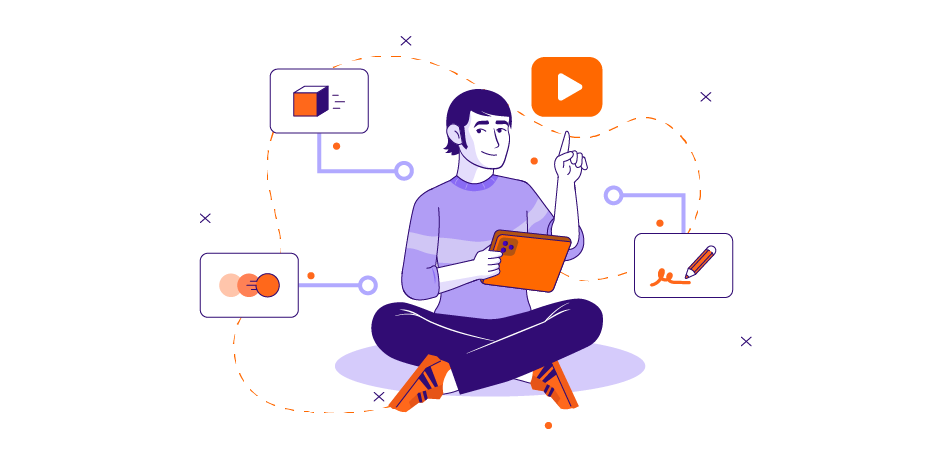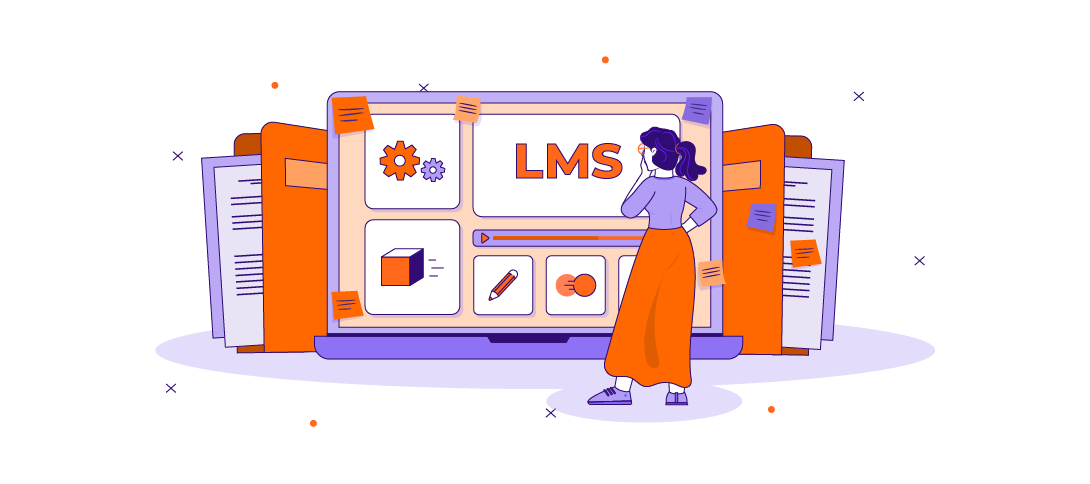
Product Knowledge Training: Everything You Need to Know
Want to take your business to the next level? Then you need one thing: excellent customer service and happy customers (okay fine; that’s two things!)
The point is that you need to deliver both on the product side and on delivering exceptional support to satisfy customers. This is what sets you apart from your competitors.
To do that, product knowledge is imperative. It’s what creates raving reviews, referrals, and satisfied customers. Without proper product knowledge training, you’re dead in the water.
Why?
Because it results in the opposite effect, irritated and annoyed customers, who are left scratching their heads as to how to solve their problem. If you’ve ever been on the other end of terrible customer support, you’ll understand what we mean.
Today, we’re going to dive into the different aspects of creating a product knowledge training program so your team members can have in-depth knowledge and become certifiable experts.
Ready to go?
Let’s do it!
What Is Product Knowledge?
Before we begin, it’s important to understand the meaning of product knowledge. So, what is product knowledge?
Product knowledge training allows employees to get a thorough understanding of all the information about your products or services. This includes a product training program for the sales team, marketing team, and customer service and can even include the end-user of a product or service to facilitate a working knowledge base for all parties involved to understand the features, benefits, and capabilities.
Simply put:
It’s an in-depth understanding of the product or service for all parties involved.

Why Is Product Knowledge Important &
What Are the Benefits?
If you’re wondering what the point of product knowledge training is, let us fill you in. There are many benefits of training your employees and sales reps to understand your products and services using bite-sized training sessions.
In order to understand the importance of a product knowledge training program, let’s discuss these benefits.
Benefits of Product Training
There’s no reason you shouldn’t have a product training program in place because there are endless uses for it. Here are the most important benefits:
1. Outstanding Customer Support
The most important aspect of your product offering should be the level of service being presented to your customers or clients. That’s why all of your employees need to be able to communicate product knowledge to your customers effectively.
This is imperative for customer acquisition and retention.
Every employee should understand product features and create a positive experience for potential customers. Without product knowledge training, the reputation of your company is on the line.
Most companies struggling to grow have one thing in common:
A collective lack of proper employee knowledge from team members.
2. Increased Sales & Revenue
A knowledgeable team of sales reps will provide the benefit of increased sales.
Why?
It’s simple:
Product knowledge training breeds confident employees. Confident employees who are passionate, well-versed, and can provide excellent support boost the reputation of the company as a whole.
Product knowledge training helps generate brand advocates inside and outside of the company. It’s just a smart investment.
It’s the difference between having a team of employees filling a role within the company versus an expert sales team that creates trust and credibility through competence.
Where do you stand?

3. Improves Product Learning Knowledge & Retention
Product knowledge training isn’t limited to employees and sales teams. Customers also need online training about your products or services. There are a few ways to do this:
1. Design an actively managed knowledge base.
2. Turn every employee into a valuable resource for product learners.
Creating a knowledge base starts with internal knowledge training. When a team member understands a product through and through, they improve the efficiency of your company. This is done by providing detailed product information throughout every step of the customer value journey, starting with documentation. Doing so results in more use of the product.
Your Knowledge base shouldn’t just be long and boring text littered with technical jargon. To provide the best customer experience (and the most value), you need to incorporate videos, animations, screencasts, product overviews, reviews, etc., into your online training. This not only makes it more interactive and engaging, but it also allows customers to retain information when learning about your product.
It all starts with developing effective employee product knowledge training for your entire organization. Do that, and you’ll build a positive company culture and instill confidence in every team member.
Long story short:
Develop product training that allows your employees and customers to be product knowledge experts. Your company will reap the benefits from reduced support requests from customers and more referrals from word-of-mouth marketing.
Product Knowledge Training Objectives (and Use Cases)
The overall objective of your product knowledge training program should be a deep understanding of features, benefits, and capabilities; the end result should be the ability to train individuals to sell, market, understand, and use the product.
To do this, you may need to include several product learning modules. Let’s go over the different use cases.
Product Sales Training for Knowledgeable Sales Reps
The most obvious use case is for sales reps. The objective for sales teams is to get the most benefit from becoming a subject matter authority specializing in your company’s product offerings.
This should be the norm for most organizations. Unfortunately, it’s not!
This provides an opportunity for those who invest in product knowledge training to have a competitive advantage over other competitors in the marketplace.
Training your sales reps with a dedicated product learning module specific to the role should educate them on topics such as:
How to sell the product. How does this product solve a problem or make the customer's life easier? What are the key selling points? What are the specific use cases that can best showcase how to meet the customers' needs? Are there any upcoming updates?
Product Use. Every sales rep should understand how to use the product themselves. They should have in-depth knowledge about every bell and whistle. If they don't, how are they supposed to answer inquiries and convert prospects into customers?
Industry Knowledge. Sales reps should have thorough knowledge of competitor offers and pricing to illustrate the benefits of your company and create value effectively. Why should they choose you over the competition?
Customer Testimonials (Success Stories). Most companies have a list of testimonials on their website. However, if a customer were to ask your sales reps to what degree of success others have used your product, would they be able to answer effectively? Are there any recognizable names you've worked with? Incorporating examples of success into your online training makes selling and social proof second nature for employees.
Product Knowledge Training for Customer Service
Product knowledge for customer support employees is almost as important as it is for sales reps. In some cases, it’s even more important.
Why?
The success of a company isn’t just about making sales. It’s also about customer retention after the sale.
The objective of product knowledge training for customer service employees is to provide quality support that instills trust and confidence, so customers keep coming back (and spreading goodwill).
Product knowledge training for customer service should include the following for learners:
Answers to Common Support Questions. What are the most frequently asked questions about your product or service? It's important that employees are well-trained on how to answer common questions to provide an excellent support experience. This can also be documented in your knowledge base.
Technical Training. This is probably the most essential aspect of product knowledge for customer service since it will be the most common inquiry. There needs to be a deep understanding of how your product works, along with standard troubleshooting issues.
Warranty information. Make sure employees understand warranty info, return policies, and any related information about the product. The goal here is to provide a quality experience and remove any stress for the customer.
Product Recommendations. Is there a way to upsell, cross-sell, or provide substitute or supporting product information for your customers? This should be included in your employee training since it helps with customer retention and can possibly provide additional sales.

Product Knowledge Training for Marketers
Some say a sale is made before a customer’s first touchpoint with the company. How so? Marketing!
Most marketing teams never receive any substantial level of product training. This is a mistake since they are in direct control of the messaging of your product or service.
How can you accurately describe something you don’t understand? What are you leaving out of your marketing campaigns in terms of communicating the product to your audience?
The objective of product knowledge training for marketing professionals should be to accurately understand how to describe the uses and the problems a product solves to potential customers.
Here’s what should be included in the training modules for your marketing team:
Product Info. Similar to the sales department, marketers need to understand all the ins and outs of the product and its features to attract the right audience and have the ability to "sell" the product. Using videos can be very useful for employee training in this case.
Customer Data. The marketing department should have thorough knowledge of lifestyle and psychographic information in order to promote the product better. This helps with audience targeting and understanding what motivates customers to make a purchase (and why) over the long term, which can be useful in improving campaigns.
Industry Knowledge. Similar to the sales department, marketers need to obtain industry-related training to understand customers, competitors, and the business as a whole. Employees working on selling products to a targeted audience should develop strategies that help provide a unique selling proposition (or USP) with confidence. An overview of the marketplace can assist with this.
Product Training (Learning) For Customers
Another learning module to implement is product training for customers. The objective here is to properly onboard customers and indoctrinate them into your business or brand with product knowledge. Some of the biggest brand advocates get enamored with a brand through training.
Training customers should provide word-of-mouth referrals and online social sharing to expand your reach. It can also help reduce the workload of your employees. If customers are properly trained on a product, they won’t need as much assistance from sales reps or customer service.
When you develop your training modules for customers, be sure to include bite-sized information about the following:
Onboarding Information. At the start of your customer training, don't just jump right into product knowledge. It's important to understand the customer's needs, address them, and make them feel welcome. Begin by putting yourself in their shoes and making them feel understood. Discuss the basic product info and how it will make their life easier. This will go a long way toward retention.
Feature Walk-Through. Be sure to give detailed information about the features and uses of the product and walk the customer through each one sequentially. Avoid using industry jargon or "talking over their head." Keep it simple.
Step-by-Step Tutorials. Does your product cater to specific industries or have common use cases? Providing online instructions, step-by-step, helps guide someone through each task or each part of the process. For example, how to assemble the product or what to do if the motor overheats. (It's always the motor, isn't it?)
FAQs. Be sure to include answers to frequently asked questions in your customer training. They can be repurposed from your employees' learning modules as well, with some slight modifications.
Contact Info. Whatever you do, make sure to include contact information in case a new user needs access to more information. Many companies look for the best way to avoid customer contact. However, providing the best way to get further assistance (email, phone, live chat) instills confidence and improves the reputation of your business. At Ninja Tropic, we always make our contact info available.
What Are the Different Types of Product Knowledge?
There are quite a few different types of product knowledge you may want to incorporate into your learning management system (LMS). We’ve covered a few already, but here’s a short list of things to consider when creating your company’s training modules for the growth and success of your business.
Mobile Learning
Mobile learning, also known as M-learning, is an excellent option for your LMS that allows you to incorporate training to educate your employees through the use of digital devices such as smartphones or tablets.
Blended Learning
Blended education allows for the ability to combine in-person instruction with a mobile learning environment. The ability to increase knowledge retention with engaging online materials for employees makes blended learning a highly sought-after option for your LMS.
Microlearning
Microlearning is the use of short, educational explainer videos that use live action and animation to create engaging eLearning content. The idea is to break complex topics down into short-form training sessions that are easy to understand.
Video Animation
Video animation allows for highly engaging content that improves the eLearning experience for companies and employees. Whether it’s for online sales training or building skills for your customer service team, video animation helps to increase knowledge retention.
Interactive Videos
Interactive video gives you the ability to allow employees to be in control of their training by making them part of the story. This is typically done with interactive quizzes, “choose your own adventure” (or branched story) videos, and question and answer format.
Scenario-Based Learning
Adding scenario-based learning into your eLearning experience for employees and customers allows for the use of role-play to deepen understanding. This is great for sales reps as you can walk through a few scenarios that can help improve their skills.
Video Storytelling
Video storytelling is a key component of establishing brand awareness as a strategy in your brand messaging. However, it’s also an integral part of the internal training process and may be used for employee onboarding. It starts with creating a narrative to implement into your training.

How to Develop, Implement, and Automate Product Knowledge Training
To develop your product knowledge training and successfully scale your business, you just need to follow the following steps.
Step 1: Create an LMS or Internal Training Course
In order to improve efficiency, you need to get an idea of what type of training your company needs. You can either create your LMS on your own or choose to go with an eLearning agency that offers custom development. In either case, you’ll need to conduct a training needs analysis to outline the type of knowledge training you would like to produce.
Step 2: Choose Your eLearning Solutions
Once you have an idea of which training to produce, you’ll need to select which types of eLearning solutions you’d like to incorporate into the production process. You may already have some key ideas in mind. If not, you may want to review the section on product knowledge types (or our website) to get a headstart on improving the performance of your training.
Step 3: Produce Your Training Assets
This step requires a bit of planning. Mostly because it requires a small amount of technical setup, like obtaining the proper equipment and video editing software. You’ll also want to determine the KPIs or training objectives, script your videos, and do some editing in post-production. Check out our post about planning effective training videos for more information.
Step 4: Test Your eLearning Experience
After everything is recorded, produced, edited, and ready to go, you’ll want to test it. This is done by simply informing an initial group of employees (beta testers) to go through the training and providing their feedback. Once you get a few of your sales reps or employees to take the online training, you’ll want to measure the performance to ensure the objectives were met.
Step 5: Automate Your Workflows
As long as you’re satisfied with the training system you’ve put in place, you may want to put some processes in place to make life easier as you grow. Here are just a few things you can do to save time:
Automatically add employees to your LMS during the onboarding process.
Enroll them in the right training courses based on their department and job description.
Create an email sequence that walks them through the training modules automagically (nope, not a typo.)
Field any feedback and provide any results from Q&A modules.
At the end of the day, you want to streamline the entire training process to scale effectively.
Step 6: Measure and Improve
After some time, you should have everything you need in place to make your training run like clockwork. However, what do you do with the employee feedback? Once you acquire enough data, you’ll want to make tweaks or improvements to the program to improve its effectiveness. You can measure its performance and continuously refine it for better results.

Final Thoughts on Product Knowledge Training
So there you have it! That’s everything you need to know to create effective product training. You just need to understand the product knowledge training needs of your company and take it step by step. Need some help along the way? Feel free to contact us for custom eLearning development.
